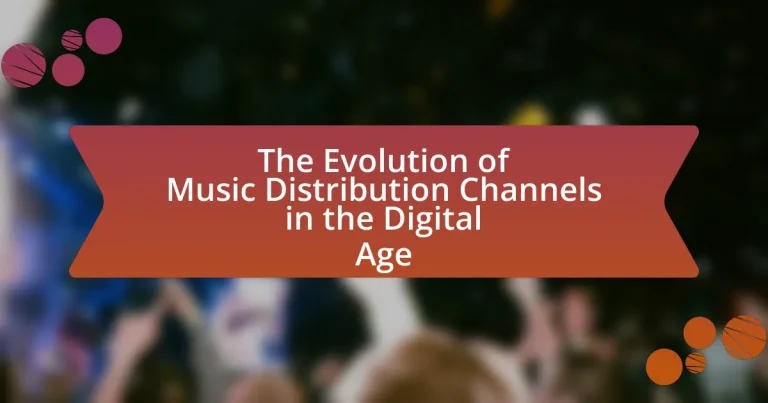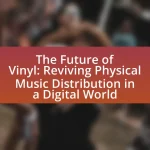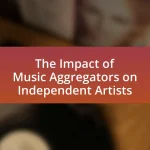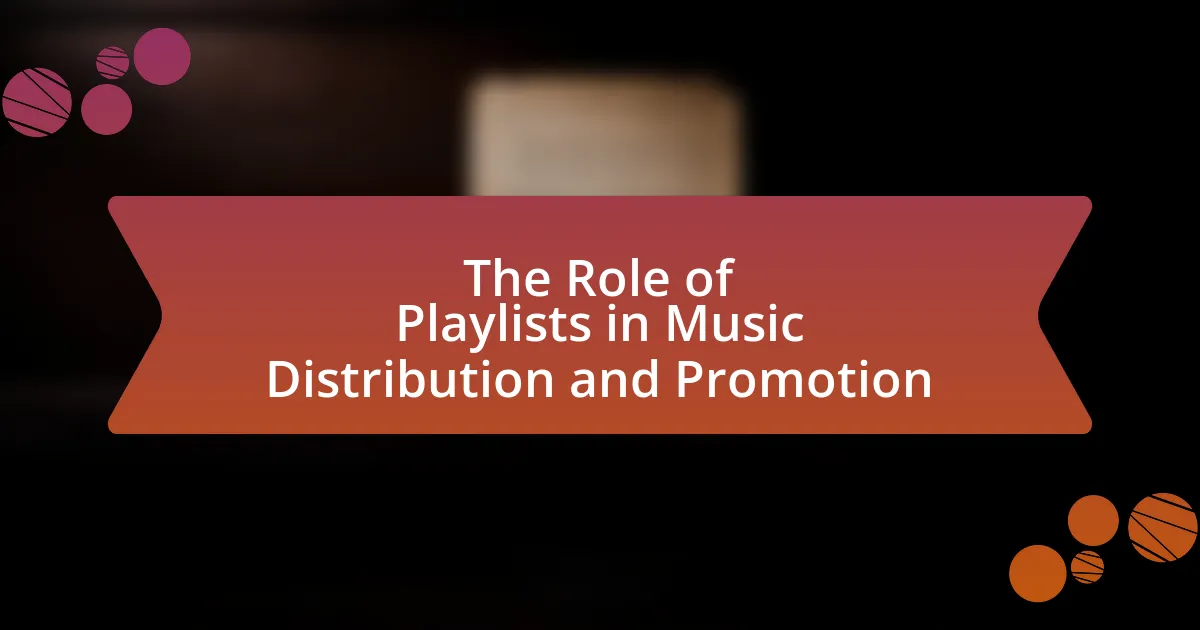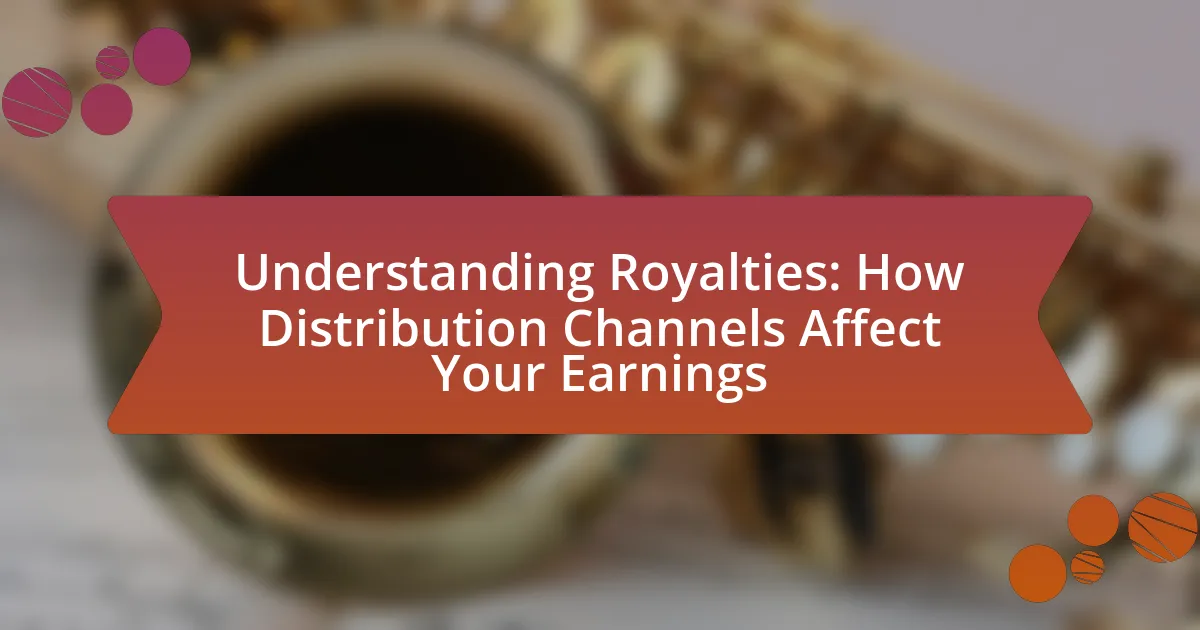The article focuses on the evolution of music distribution channels in the digital age, highlighting key changes such as the shift from physical formats to digital platforms, the rise of streaming services, and the democratization of music distribution. It examines how technology has influenced these changes, emphasizing the impact of streaming platforms, social media, and digital marketing on music accessibility and consumer behavior. Additionally, the article addresses challenges faced by artists, including market saturation and copyright issues, while exploring future trends like blockchain technology and virtual reality in music distribution. Overall, it provides a comprehensive overview of how the digital landscape has transformed the music industry and the implications for artists and consumers alike.
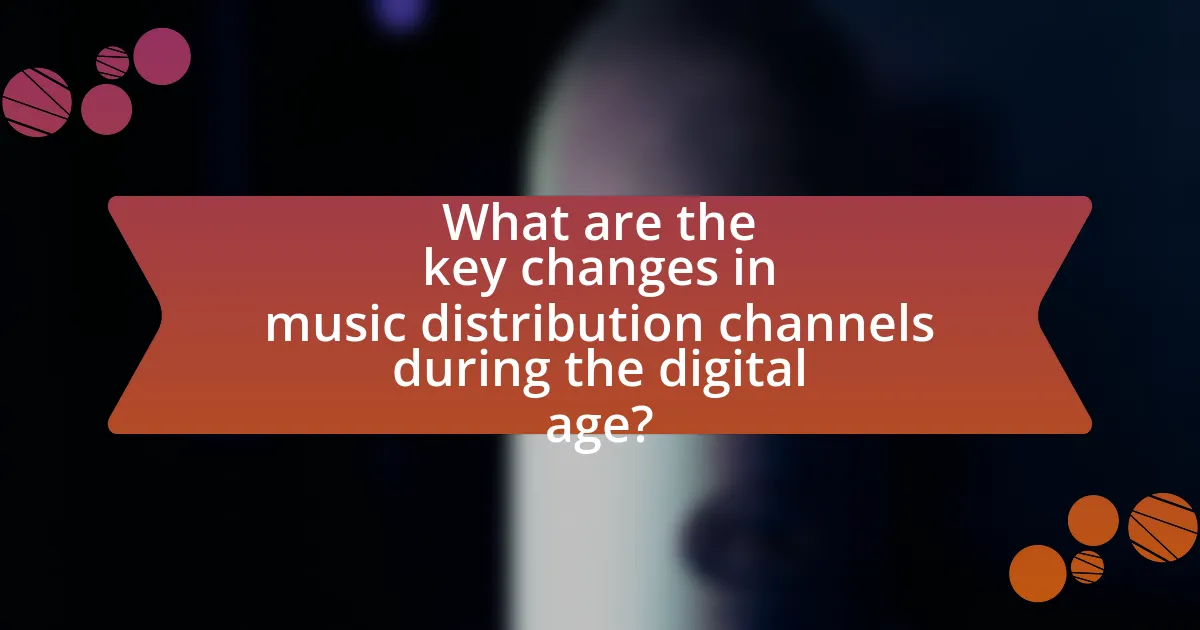
What are the key changes in music distribution channels during the digital age?
The key changes in music distribution channels during the digital age include the transition from physical formats to digital platforms, the rise of streaming services, and the democratization of music distribution. Historically, music was primarily distributed through physical media such as vinyl records, cassettes, and CDs, which required significant investment and infrastructure. With the advent of the internet, digital downloads became prevalent, allowing consumers to purchase and own music files directly.
Streaming services like Spotify and Apple Music have since revolutionized access to music, enabling users to listen to vast libraries without ownership, fundamentally altering consumption habits. According to the Recording Industry Association of America (RIAA), streaming accounted for over 80% of the U.S. music industry’s revenue in 2020, highlighting its dominance over traditional sales.
Additionally, digital platforms have empowered independent artists by providing direct access to audiences without the need for traditional record labels, as evidenced by the growth of platforms like Bandcamp and SoundCloud. This shift has led to a more diverse music landscape, where artists can reach global audiences directly.
How has technology influenced music distribution?
Technology has significantly transformed music distribution by enabling digital platforms that facilitate instant access to music globally. The advent of the internet and streaming services like Spotify and Apple Music has shifted the focus from physical sales, such as CDs and vinyl, to digital downloads and streaming, which accounted for over 80% of music revenue in 2020 according to the Recording Industry Association of America (RIAA). This transition has democratized music distribution, allowing independent artists to reach audiences without traditional record label support, as evidenced by the rise of platforms like Bandcamp and SoundCloud. Additionally, social media has become a crucial tool for marketing and promoting music, further enhancing the accessibility and reach of artists.
What technological advancements have shaped music distribution?
Technological advancements that have shaped music distribution include the transition from physical media to digital formats, the rise of the internet, and the development of streaming services. The shift from vinyl records and CDs to digital files allowed for easier storage and sharing of music. The internet enabled global access to music, facilitating the emergence of platforms like Napster in the late 1990s, which revolutionized peer-to-peer sharing. Streaming services such as Spotify and Apple Music, launched in the 2000s, further transformed distribution by providing on-demand access to vast music libraries, changing consumer behavior and industry revenue models. These advancements collectively disrupted traditional distribution channels and redefined how music is consumed and monetized.
How do streaming platforms differ from traditional distribution methods?
Streaming platforms differ from traditional distribution methods primarily in their delivery mechanism and accessibility. Streaming platforms provide on-demand access to music via the internet, allowing users to listen instantly without the need for physical media or downloads, while traditional distribution methods rely on physical formats like CDs or vinyl, which require purchase and ownership. For example, in 2022, streaming accounted for 83% of the U.S. music industry’s revenue, highlighting the shift from physical sales, which have significantly declined, with CD sales dropping by over 70% since 2000. This transition reflects a broader trend towards digital consumption, where convenience and immediate access are prioritized over ownership.
What role do social media and digital marketing play in music distribution?
Social media and digital marketing are crucial in music distribution as they enable artists to reach wider audiences and promote their music effectively. Platforms like Instagram, Facebook, and TikTok allow musicians to share their work directly with fans, facilitating viral marketing and engagement. According to a 2021 report by the International Federation of the Phonographic Industry, 70% of music consumers discover new music through social media platforms, highlighting their impact on music distribution. Additionally, digital marketing strategies, such as targeted advertising and influencer partnerships, enhance visibility and drive streaming numbers, further solidifying the role of these tools in the modern music landscape.
How can artists leverage social media for music distribution?
Artists can leverage social media for music distribution by utilizing platforms like Instagram, Facebook, and TikTok to share their music directly with audiences. These platforms allow artists to create engaging content, such as music videos, behind-the-scenes footage, and live performances, which can increase visibility and fan engagement. According to a 2021 report by the International Federation of the Phonographic Industry, 75% of music consumers discover new music through social media, highlighting its effectiveness as a distribution channel. Additionally, artists can use targeted advertising on these platforms to reach specific demographics, further enhancing their distribution efforts.
What are the impacts of digital marketing on music reach and engagement?
Digital marketing significantly enhances music reach and engagement by leveraging online platforms to connect artists with broader audiences. Through social media, streaming services, and targeted advertising, musicians can promote their work to specific demographics, resulting in increased visibility. For instance, a study by the International Federation of the Phonographic Industry (IFPI) in 2021 indicated that 70% of music listeners discover new music through digital platforms, showcasing the effectiveness of digital marketing strategies. Additionally, engagement metrics such as likes, shares, and comments on social media posts provide artists with immediate feedback and foster community interaction, further amplifying their reach.
What challenges have emerged in music distribution in the digital age?
Challenges in music distribution in the digital age include market saturation, revenue fragmentation, and copyright issues. Market saturation arises as numerous artists and labels compete for listener attention on streaming platforms, making it difficult for individual musicians to stand out. Revenue fragmentation occurs due to the diverse range of platforms and services, leading to inconsistent income streams for artists; for instance, Spotify pays artists an average of $0.003 to $0.005 per stream, which can be insufficient for many. Additionally, copyright issues have become more complex, with the rise of user-generated content and the need for clear licensing agreements, often resulting in legal disputes and financial losses for creators.
How do copyright issues affect digital music distribution?
Copyright issues significantly impact digital music distribution by determining the legal rights of creators and the accessibility of their work. These legal frameworks dictate how music can be shared, streamed, or downloaded, influencing platforms like Spotify and Apple Music. For instance, the Digital Millennium Copyright Act (DMCA) in the United States establishes guidelines for copyright protection in the digital realm, requiring platforms to remove infringing content upon notification. This legal structure affects how artists monetize their work and how consumers access music, as unauthorized distribution can lead to legal repercussions for both parties. Additionally, copyright laws can limit the availability of certain tracks in specific regions, further shaping the landscape of digital music distribution.
What are the financial implications for artists in the digital distribution landscape?
The financial implications for artists in the digital distribution landscape include reduced revenue per unit sold and increased access to global markets. Digital platforms typically offer lower per-stream payouts compared to traditional sales, with average payouts ranging from $0.003 to $0.005 per stream, significantly impacting overall earnings. However, these platforms also enable artists to reach a wider audience without the need for physical distribution, potentially increasing overall sales volume. For instance, a study by the International Federation of the Phonographic Industry (IFPI) reported that global recorded music revenues grew by 7.4% in 2020, largely driven by streaming, indicating that while individual payouts are lower, the overall market is expanding, providing new financial opportunities for artists.
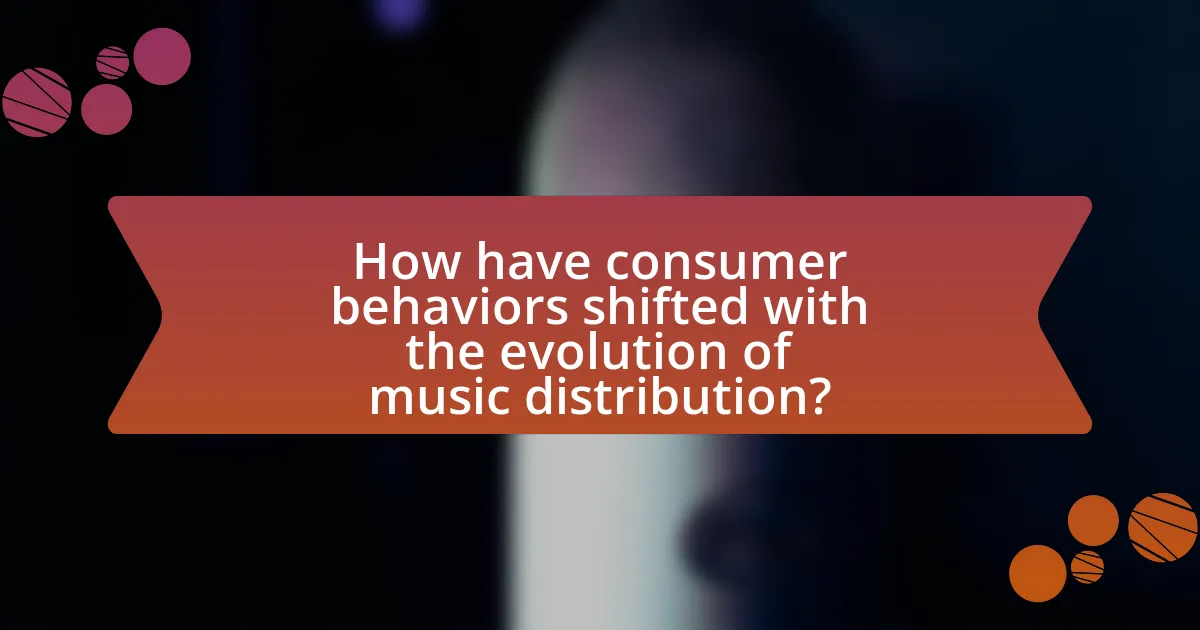
How have consumer behaviors shifted with the evolution of music distribution?
Consumer behaviors have shifted significantly with the evolution of music distribution from physical formats to digital platforms. This transition has led to increased accessibility and convenience, allowing consumers to stream or download music instantly rather than purchasing physical albums. For instance, the rise of streaming services like Spotify and Apple Music has resulted in a decline in physical sales, with digital music revenue surpassing physical sales for the first time in 2015, according to the Recording Industry Association of America (RIAA). Additionally, consumers now prioritize curated playlists and personalized recommendations, reflecting a shift towards on-demand listening experiences rather than traditional album purchases. This change indicates a broader trend of valuing immediacy and personalization in music consumption.
What are the trends in music consumption among listeners today?
Music consumption trends among listeners today indicate a significant shift towards streaming services, with platforms like Spotify and Apple Music dominating the market. In 2022, streaming accounted for over 80% of music industry revenue in the United States, reflecting a preference for on-demand access over physical sales or downloads. Additionally, listeners are increasingly favoring curated playlists and algorithm-driven recommendations, which enhance personalized music experiences. This trend is supported by data showing that 60% of users discover new music through playlists rather than traditional radio or album purchases.
How do subscription services compare to purchasing music outright?
Subscription services provide access to a vast library of music for a monthly fee, while purchasing music outright involves buying individual tracks or albums for permanent ownership. Subscription services, such as Spotify and Apple Music, allow users to stream millions of songs without the need for individual purchases, which can be more cost-effective for frequent listeners. In contrast, purchasing music outright grants users permanent access to specific songs or albums, which can be beneficial for collectors or those who prefer to own their music. According to a report by the Recording Industry Association of America (RIAA), subscription services accounted for 83% of the U.S. music industry’s revenue in 2022, highlighting their growing dominance over traditional purchasing methods.
What factors influence listener preferences in music distribution?
Listener preferences in music distribution are influenced by factors such as accessibility, genre variety, social influence, and personalization. Accessibility refers to the ease with which listeners can access music through various platforms, with streaming services like Spotify and Apple Music leading the way due to their vast libraries and user-friendly interfaces. Genre variety plays a crucial role, as listeners often prefer platforms that offer a wide range of musical styles, catering to diverse tastes. Social influence, including recommendations from friends and social media trends, significantly impacts listener choices, as people tend to gravitate towards popular or trending music. Personalization features, such as curated playlists and algorithm-driven suggestions, enhance user experience by tailoring content to individual preferences, thereby increasing engagement and satisfaction. These factors collectively shape how listeners interact with music distribution channels in the digital age.
How has the accessibility of music changed for consumers?
The accessibility of music for consumers has significantly increased due to the rise of digital distribution channels. Streaming services like Spotify and Apple Music have made vast libraries of music available instantly, allowing users to listen to millions of songs on-demand without the need for physical media. According to the Recording Industry Association of America (RIAA), streaming accounted for 83% of the U.S. music industry’s revenue in 2020, highlighting the shift from traditional purchasing methods to digital access. This transformation has enabled consumers to discover and enjoy music more easily than ever before, breaking geographical barriers and reducing costs associated with purchasing albums or singles.
What impact does mobile technology have on music accessibility?
Mobile technology significantly enhances music accessibility by enabling users to stream and download music anytime and anywhere. This advancement allows individuals to access vast libraries of music through platforms like Spotify and Apple Music directly from their smartphones. According to a report by the International Federation of the Phonographic Industry (IFPI), 70% of music consumption now occurs via mobile devices, illustrating the shift in how people engage with music. This accessibility democratizes music distribution, allowing independent artists to reach global audiences without traditional barriers, thus reshaping the music industry landscape.
How do global markets affect music distribution strategies?
Global markets significantly influence music distribution strategies by necessitating localized approaches to reach diverse audiences effectively. As music consumption varies across regions due to cultural preferences and technological access, distribution strategies must adapt to these differences. For instance, streaming services like Spotify and Apple Music tailor their catalogs and marketing efforts to align with regional tastes, which is evident in their localized playlists and partnerships with local artists. Additionally, the rise of digital platforms has enabled independent artists to access global markets directly, leading to a shift in traditional distribution models that previously relied on major labels. This adaptability is crucial, as the global music market was valued at approximately $23 billion in 2020, highlighting the importance of strategic distribution to capture market share across various demographics and regions.
What are the implications of user-generated content on music distribution?
User-generated content significantly impacts music distribution by democratizing access and enabling independent artists to reach wider audiences without traditional gatekeepers. Platforms like YouTube and SoundCloud allow users to upload and share music, leading to viral trends and increased visibility for emerging artists. According to a 2021 report by the International Federation of the Phonographic Industry, 70% of music consumers discover new music through user-generated content platforms, illustrating the shift in how audiences engage with music. This shift not only alters traditional distribution models but also empowers artists to build direct relationships with fans, bypassing conventional record label structures.
How does user-generated content influence music discovery?
User-generated content significantly influences music discovery by providing authentic recommendations and diverse perspectives that traditional media often lack. Platforms like TikTok and YouTube allow users to share their music preferences, creating viral trends that can propel lesser-known artists into the mainstream. For instance, a study by the University of Southern California found that songs featured in user-generated videos on TikTok experienced a 1,000% increase in streams on Spotify. This demonstrates how user-generated content not only enhances visibility for artists but also shapes listener preferences, making it a crucial element in the modern music distribution landscape.
What role do platforms like YouTube play in music distribution?
Platforms like YouTube serve as significant channels for music distribution by enabling artists to reach global audiences directly. YouTube allows musicians to upload their music videos, which can be accessed by millions of users, thus bypassing traditional distribution methods like record labels and physical sales. In 2022, YouTube reported over 2 billion logged-in monthly users, highlighting its vast reach and influence in the music industry. Additionally, the platform provides monetization opportunities through ad revenue and subscriptions, further incentivizing artists to use it as a primary distribution method.
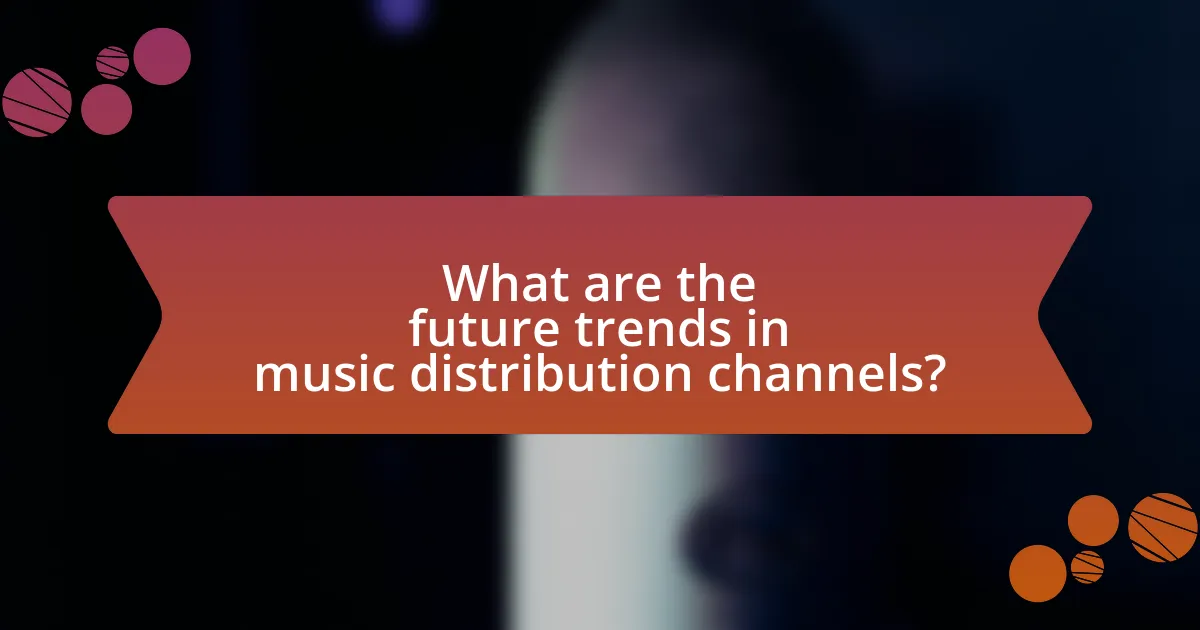
What are the future trends in music distribution channels?
Future trends in music distribution channels include the rise of direct-to-consumer platforms, increased use of blockchain technology, and the growing importance of social media for music promotion. Direct-to-consumer platforms allow artists to distribute their music without intermediaries, enhancing their revenue share. Blockchain technology offers transparent royalty tracking and ensures fair compensation for artists, as seen in initiatives like Audius. Additionally, social media platforms are becoming essential for music discovery and engagement, with TikTok leading the way in viral music trends, as evidenced by the significant number of songs that gain popularity through user-generated content on the platform.
How might emerging technologies reshape music distribution?
Emerging technologies are likely to reshape music distribution by enabling decentralized platforms and enhancing direct artist-to-fan interactions. Blockchain technology, for instance, allows artists to distribute their music without intermediaries, ensuring they receive a larger share of revenue. According to a report by the International Music Summit, blockchain could potentially increase artist earnings by up to 30% by eliminating traditional distribution costs. Additionally, advancements in artificial intelligence can personalize music recommendations, improving user engagement and driving sales through targeted marketing. These technologies collectively create a more efficient, transparent, and artist-friendly distribution landscape.
What potential does blockchain technology hold for music distribution?
Blockchain technology holds significant potential for music distribution by enabling direct transactions between artists and consumers, thereby eliminating intermediaries. This direct interaction can lead to increased revenue for artists, as they retain a larger share of their earnings. Additionally, blockchain’s transparent ledger system allows for real-time tracking of music usage and royalties, ensuring that artists are fairly compensated for their work. For instance, platforms like Audius utilize blockchain to provide artists with control over their music and earnings, demonstrating the practical application of this technology in the industry.
How could artificial intelligence impact music distribution strategies?
Artificial intelligence could significantly enhance music distribution strategies by optimizing content delivery and personalizing user experiences. AI algorithms analyze listener data to predict preferences, enabling targeted marketing and tailored playlists that increase engagement. For instance, platforms like Spotify utilize machine learning to recommend songs based on user behavior, which has been shown to improve user retention rates. Additionally, AI can streamline distribution processes by automating tasks such as royalty calculations and rights management, reducing administrative burdens for artists and labels. This efficiency not only accelerates the distribution timeline but also ensures accurate compensation, fostering a more sustainable ecosystem for creators.
What are the predictions for the evolution of music distribution platforms?
Predictions for the evolution of music distribution platforms indicate a shift towards decentralized models and enhanced user engagement. As blockchain technology gains traction, platforms may adopt decentralized systems that allow artists to distribute music directly to consumers, reducing reliance on traditional intermediaries. Additionally, the rise of artificial intelligence is expected to personalize music recommendations, creating tailored listening experiences that enhance user satisfaction. According to a report by MIDiA Research, the global music streaming market is projected to grow to $23 billion by 2025, highlighting the increasing importance of digital platforms in music distribution. This growth suggests that platforms will continue to innovate, focusing on user-centric features and direct artist-to-fan interactions.
How might the rise of virtual reality affect music experiences and distribution?
The rise of virtual reality (VR) is likely to transform music experiences and distribution by creating immersive environments for listeners and enabling new forms of engagement. VR allows users to attend virtual concerts, interact with artists in real-time, and experience music in a 360-degree space, enhancing emotional connections to the music. For instance, platforms like Oculus Venues have already hosted live performances where users can feel as if they are physically present at the event, which can lead to increased ticket sales and new revenue streams for artists. Additionally, VR can facilitate personalized music experiences, allowing users to curate their own environments and interactions, which may shift traditional distribution models from passive listening to active participation. This evolution aligns with the growing trend of experiential consumption in the digital age, where consumers seek more than just audio content; they desire engaging, multi-sensory experiences.
What trends are likely to emerge in artist-fan interactions through distribution channels?
Emerging trends in artist-fan interactions through distribution channels include increased personalization, direct engagement, and the use of immersive technologies. Personalization is driven by data analytics, allowing artists to tailor content and experiences to individual fan preferences, enhancing emotional connections. Direct engagement is facilitated by social media platforms and streaming services, enabling artists to communicate with fans in real-time, fostering community and loyalty. Additionally, immersive technologies like virtual reality and augmented reality are being integrated into distribution channels, offering fans unique experiences such as virtual concerts and interactive content. These trends are supported by the growing use of platforms like TikTok and Twitch, which prioritize direct artist-fan interactions and provide analytics that inform content strategies.
What best practices should artists follow in the evolving music distribution landscape?
Artists should prioritize digital platforms for music distribution to maximize reach and engagement. Utilizing services like Spotify, Apple Music, and Bandcamp allows artists to access a global audience and leverage data analytics for informed decision-making. Additionally, maintaining an active presence on social media enhances visibility and fosters direct connections with fans. According to a 2021 report by the International Federation of the Phonographic Industry, streaming accounted for 62% of global recorded music revenue, underscoring the importance of digital distribution. Furthermore, artists should consider direct-to-fan sales through platforms like Patreon or their own websites, which can increase revenue and build a loyal fanbase.
How can artists effectively utilize data analytics for distribution decisions?
Artists can effectively utilize data analytics for distribution decisions by analyzing streaming metrics, audience demographics, and engagement patterns. By examining data from platforms like Spotify and Apple Music, artists can identify which songs resonate most with listeners, allowing them to prioritize distribution efforts for their most popular tracks. Additionally, understanding demographic data helps artists target specific audiences, optimizing marketing strategies and distribution channels. For instance, a report from the International Federation of the Phonographic Industry (IFPI) indicates that 70% of music consumption is driven by streaming, highlighting the importance of data in making informed distribution choices.
What strategies can artists adopt to maximize their reach in digital distribution?
Artists can maximize their reach in digital distribution by leveraging multiple platforms, engaging with their audience, and utilizing data analytics. By distributing their music across various streaming services like Spotify, Apple Music, and YouTube, artists can tap into diverse listener bases. Engaging with fans through social media platforms such as Instagram, TikTok, and Twitter fosters a community and encourages sharing, which amplifies visibility. Additionally, utilizing data analytics tools allows artists to understand listener demographics and preferences, enabling targeted marketing strategies. According to a 2021 report by the International Federation of the Phonographic Industry, artists who actively engage with their audience on social media see a 30% increase in streaming numbers, demonstrating the effectiveness of these strategies.
